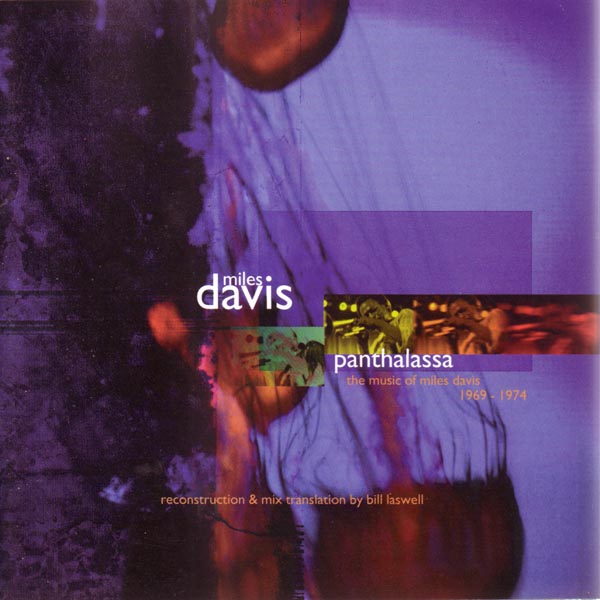MILES DAVIS


1/ In a Silent Way/Shhh/Peaceful/ (Davis/Zawinul) 15.20
It's About That Time
2/ Black Satin/Pete Cosey/ (Davis) 16.06
Aghartha Prelude Dub
3/ Rated X/Billy Preston (Davis) 14.34
4/ He Loved Him Madly (Davis) 13.38
Created at Greenpoint Studios, Brooklyn, New York
Reconstruction and mix translation by Bill Laswell
Engineering: Robert Musso
Assistant: Diabel Faye
Original sessions produced by Teo Macero
Research and transfers: Bob Belden
Text coordination and Axiom support: Bill Murphy
Material, Inc.: John Brown
Mastered by Michael Fossenkemper at Turtle Tone Studio, NYC
FEATURING - Miles Davis, Wayne Shorter, Carlos Garnett, Dave Liebman,
Joe Zawinul, Chick Corea, Herbie Hancock, Cedric Lawson, John McLaughlin,
Reggie Lucas, David Creamer, Pete Cosey, Dominique Gaumont, Colin Walcott,
Dave Holland, Michael Henderson, Harold Williams, Khalil Balakrishna, Tony
Williams, Jack DeJohnette, Al Foster, Badal Roy, Don Alias & Mtume.
1998 - Columbia (USA), CK 67909 (2x12")
1998 - Columbia (USA), CK 67909 (CD)
Hans Stoeve (courtesy of the Nadabrahma website)
[...]
Reconstruction and remixes are two of the most innovative projects within the world of electronica and dance music. Much like old school hip-hop which sampled forgotten or overlooked soul and rock tracks, reconstruction and remixing allows electronic artists to pay tribute to classic jazz and reggae artists while creating new music from these rich sources. In this way, reconstruction and remix projects effectively turn on new audiences to jazz and reggae and provide new support and energy for these often ignored genres. To their credit, reconstructionists and remixers are very explicit about their inspirations, sources and intentions as they take jazz and reggae classics to another level. Such honesty and integrity deserves to be recognized and credited, particularly given the history of rock and roll which was largely built upon the shameless white-washing of blues and "race records" for profit. Additionally, the creativity that is involved in reconstructing and remixing jazz and reggae exceeds that which is all too typical of contemporary Top 40 remixes which are designed to prompt additional record sales for artists who are already popular. Producer and bassist Bill Laswell captures the essence of Miles Davis' exceptional work during the experimental period of 1969-1974 and breathes new life into the jazz master's intricate and complex pieces. Davis was exploring unknown territories nearly decades ago, and it is here that Laswell returns with his reconstruction tools. Laswell connects diverse and multi-faceted Davis classics and give them an incredible flow and eveness, making Panthalassa: The Music of Miles Davis 1969-1974 a captivating hour-long listening pleasure in the process.
Panthalassa is divided into four sections or tracks and each weave a textured soundscape that is detailed and vibrant. Track one includes "In A Silent Way/Shhh/Peaceful/It's About That Time," and Laswell begins this reconstruction by highlighting the gentle tenderness of Davis' work. About midway through this almost fifteen-and-a-half minute piece, Davis' horn surfaces along with percussion and bass and the instruments eventually overflow with an incredible richness and fullness. Clocking in at slightly over sixteen minutes, track two includes "Black Satin/Pete Cosey/Agharta Prelude Dub." This piece should immediately appeal to fans of acid jazz band Liquid Soul which is no coincidence since that band's musical director Mars Williams has previously worked with Laswell. Track two also includes hints of the direction the late Jimi Hendrix was taking before his untimely death, as distorted guitar sounds are prominently featured in the first two-thirds of this psychedelic piece. Track three contains "Rated X/Billy Preston" and the first half of this fourteen-and-a-half minute piece is notable for its tight, precise polyrhythms which are a prototype for jungle music. In contrast, the second half of the piece has an urban grittiness thanks to a throbbing and pulsing bass and Davis' melodic horn. Panthalassa ends with the thirteen-plus minute "He Loved Him Madly" which is instrumentally layered for a peaceful, laid back, meditative effect.
As Laswell's Panthalassa: The Music of Miles Davis 1969-1974 suggests, the world of electronica, with its hybrid of cultures, styles and sounds, complicates the meaning of "new." In addition to using jazz as critical resource, some of the most intriguing electronic offerings also draw heavily on dub reggae for inspiration and direction.
[...]
(slightly edited from part of a split review - SW)
Joann D. Ball (courtesy of the Consumable Online website)